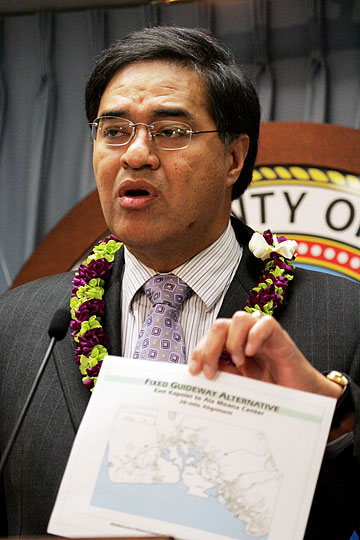Mayor says $3.6B rail affordable
Higher cost estimates for a shortened route raises funding alarms in the City Council
Honolulu Mayor Mufi Hannemann is recommending the city build a rail transit system of either 20 or 28 miles at an estimated cost of either $3.6 billion or $4.6 billion.
The shorter, less expensive route, from the eastern edge of Kapolei to Ala Moana Center, represents a 20 percent increase in the cost projections Hannemann previously made -- $3 billion.
At a City Hall news conference yesterday, Hannemann gave the City Council an analysis put together by his Honolulu High-Capacity Transit Corridor Project team.
The report reviewed the alternatives to Honolulu's traffic crisis, looking at cost, ridership and environmental and social impact.
The city team studied not building anything new except for already-planned highways and maintaining existing bus service; traffic management with more Zipper lanes and roadway changes to give buses priority; managed lanes that would include elevated, two-lane tolls road from Waipahu to downtown; and a rail system.
The study, Hannemann said, confirmed what he already knew: The rail system "would cause the least pollution, consume the least energy, result in the highest increase in transit riders and have the greatest potential to slow the growth rate of traffic congestion."
The rising costs for the two alternatives, however, staggered members of the Council.
"I'm a little shocked," Council Chairman Donovan Dela Cruz said.
"They just proved to me they don't have a handle on all the costs. He (Hannemann) said he wanted to run from Kapolei to UH, and we hadn't even gone to discuss that and he has already shortened the route.
"And the cost seems to be a moving target," Dela Cruz said, adding that he still supported a mass transit system over doing nothing.
Councilman Charles Djou, a critic of the transit plan, said he also was worried about Hannemann's math.

CRAIG T. KOJIMA / CKOJIMA@STARBULLETIN.COM
Mayor Mufi Hannemann held a sheet showing a proposed fixed-guideway route during yesterday's news conference.
|
|
"First it was $3 billion, and now it is $3.6 billion. I am very concerned if all this math doesn't add up.
"Is it worth it? It is if money grew on trees, yes. The concern is whether the people of Oahu can afford this. It is a lot of money that people simply don't have," Djou said.
Hannemann attributed the rising costs in part to delaying construction.
"The longer you push these projects out, the more expensive these projects become," Hannemann said.
Asked about the 20 percent increase in the projections for the shorter route, Hannemann said: "It is the cost of doing business, the engineering and all the construction work that has to occur."
Asked if he thought the city should build the 20- or 28-mile route, Hannemann said he saw the advantages of both. The city could afford the 20-mile route with the excise tax increase set to start in January, but Hannemann said he also saw the value in the more expensive, 28-mile route.
The longer route would cost nearly 28 percent more than the revised shorter route.
"If we want the whole enchilada, the whole manapua, we are going to need help to do this. The GET (excise tax increase) is not going to get us there," Hannemann warned.
If the city wants to build the 28-mile route, from the western edge of Kapolei to the University of Hawaii's Manoa campus, the extra $1 billion would have to be raised from new sources, Hannemann said.
"It doesn't necessarily have to be another tax increase. If the public-private partnership really kicks in, it could come from that," Hannemann said. He also suggested that the city consider floating bonds for the additional costs.
The alternative of raising taxes prompted Djou to say, "We have heard the first shot of whether or not the half-percent tax increase will be enough, and whether we have to have another tax increase to fund this system."
According to Hannemann's report, even the 20-mile route would be a better alternative than the other options studied.
The report said, "although less effective than the full corridor system, the 20-mile alignment is still more effective in providing improved mobility."
The rail-transit system, the report said, would include new stations in areas that could be zoned for new development or redevelopment.
According to the state law passed with the excise tax increase, the Council must pick a "locally preferred alternative" by the end of the year. Dela Cruz said the Council would do it, but "we can't rush a $3 million project."
After the Council decides on which alternative it wants, an environmental impact study must be prepared, and then preliminary engineering will start. Hannemann said he hoped the city could break ground on the project by 2009.
Other major questions that are still undecided include what sort of transit technology will be used, development of a plan for paying for the system and environmental issues to be resolved.
CORRECTION
Wednesday, November 1, 2006
» Projected daily trips on the proposed rail-transit system would be 123,700 for the 28-mile route and 95,000 for the 20-mile route. Incorrect figures of 294,100 (for the 28-mile route) and 281,900 (for the 20-mile one) -- total estimated trips on all transit systems -- were given in a chart on Page A1 of yesterday's Star-Bulletin.
|

